Dinger's Aviation Pages
The Dyott Monoplane and Biplane Type AT
The Story of George Dyott's Monoplane and WW1 Battleplane.
Updated with new information in January 2025.
Origins and Background.
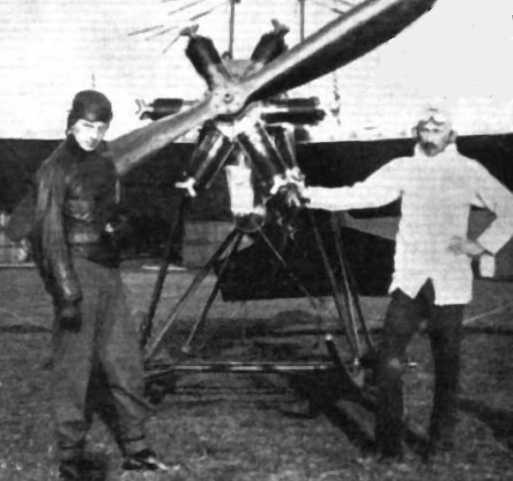
George Dyott and Captain Patrick Hamilton pose with one of their Deperdussin monoplanes.
The Story of George Dyott's Monoplane and WW1 Battleplane.
Updated with new information in January 2025.
Origins and Background.

George Dyott and Captain Patrick Hamilton pose with one of their Deperdussin monoplanes.
George Miller Dyott was born in New York City in the USA in 1883. His father was British and his mother American. He grew up in Freeford Manor, the family minor stately home and estate in England and then trained as an electrical engineer. He moved to the USA, working for a while for the Westinghouse company in Pittsburg. Around 1910 he moved to stay with relatives at Long Island and there he met pioneer aviator Henry W Walden, builder of the first American monoplane, and got the aviation "bug". He seems to have first learnt to fly in the USA. Dyott then came back to England where he obtained his Royal Aero Club Certificate (the 114th to be issued) on the 12th of March 1911¹. In the UK he met Captain Patrick Hamilton an Army officer on extended leave from his regiment in India, together they purchased two Deperdussin monoplanes (one single-seater the other with twin seats) and had them shipped over to the USA. In America, they embarked on an exhibition tour with the Deperdussins, including an amazing flight at Nassau Boulevard Airfield on Long Island, New York at night with a searchlight mounted to the undercarriage of one of the aircraft, powered by wires to the ground! In November 1911, they went to Mexico as part of an exhibition organised by the Moisant International Aviators organisation to mark the inauguration of the new Mexican president, Francisco Madero. It was Dyott who took President Madero up for a flight in the two-seat Deperdussin, the first elected head of state to have flown in an aeroplane. Also on the exhibition trip to Mexico were Alfred "Fred" Moisant and his sister, the pioneer female aviator Matilde Moisant and the equally pioneering, Harriet Quimby. Dyott and Hamilton returned to England in February 1912. Hamilton obtained his Royal Aero Club Certificate in March and applied to be transferred to the new Royal Flying Corp (RFC). Quimby also went to Europe. In April 1912, She borrowed a Blériot monoplane from Louis Blériot himself to become the first woman to fly the English Channel. She was killed only three months later, on the 1st of July 1912, when she and her passenger were thrown from a Blériot monoplane during an "Aviation Meet" in Boston, USA². Sadly, Captain Patrick Hamilton was to die in September of that same year in a crash that was to lead to the temporary banning of the flying of monoplanes by the RFC.
The Dyott Monoplane
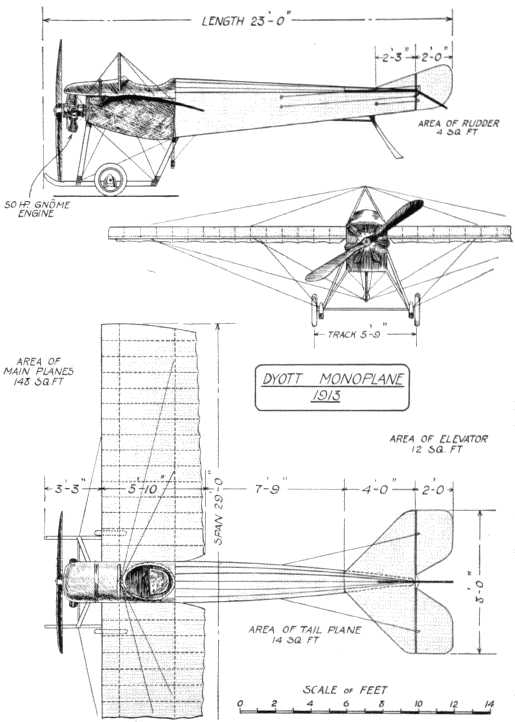
Contemporary diagram of the Dyott Monoplane
Needing a new aircraft, Dyott had contacted the newly created Hewlett & Blondeau company to build one. The company had been formed by Gustave Blondeau and Hilda Hewlett to build airframes and aircraft parts. Hilda Hewlett was married to Maurice Henry Hewlett, one of the most successful writers of the day, famous for his historical romances. She could therefore afford to pursue her passion for mechanical engineering, including a love of bicycles and motorcars. This led in turn to a fascination for aviation, which took her to France where she met Gustave Blondeau. She went into partnership with him to open a flying school at the famous Brooklands aerodrome in England. She purchased her own Farman biplane and in August 1911 she gained the first Royal Aero Club Certificate (number 122) to be awarded to a woman. Their flying school was an initial success, training many of the pioneer British aviators but competition from the many other schools that opened in 1912 made them switch to aircraft construction. They took over the premises of the short-lived "Mulliner's Aerocraft Works"³ in Vardens Road, Battersea in South London, a former roller-skating rink. After some disputes with local Unions, the new factory started operating in 1912 and the Dyott monoplane was one of their first projects, alongside licence production of Hanriot designs and the building of a pair of Royal Aircraft Factory designed BE2as for the Admiralty.

On the left is George Dyott, in the middle is Hilda Hewlett and on the right is Gustave Blondeau.
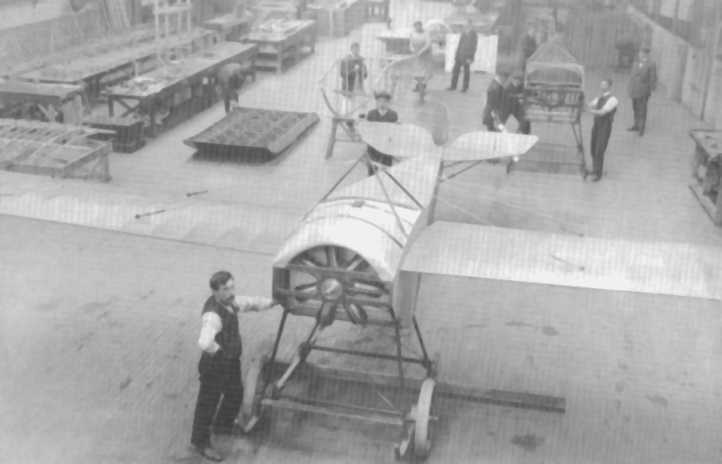
A monoplane under construction at the Hewlett and Blondeau "Omnia Works" in Battersea, with Gustave Blondeau standing next to it. In the background, two very similar fuselages look to be under construction. The figure in the light-coloured overall, at the rear of one of the fuselages, may be Hilda Hewlett. Is this the Dyott monoplane? Or could it be one of the very similar Hanriot D.1 monoplanes? It seems to have the "pyramid" of struts over the fuselage used by the Hanriot design.
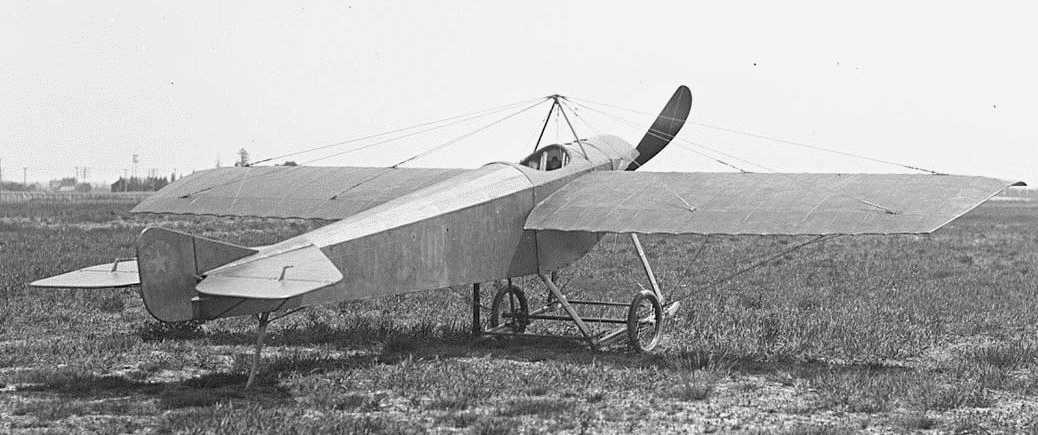
The Dyott Monoplane without its owner's name painted on the side, as it first appeared in March/April of 1913. Notice the pylon below the fuselage, to the rear of the undercarriage.
The aircraft they built for Dyott was a mid-wing monoplane, somewhat similar in layout to the Morane-Saulnier type"H" monoplane that was later to inspire the Fokker "Eindekker" fighter. Contemporary press releases said it had been designed by Dyott himself, a narrative that has followed descriptions of it through the years, right up to its entry in Wikipedia today. However, it is very close in size, layout and shape to the French Hanriot D.I monoplane, which Hewlett & Blondeau were making under licence for export back to France and also to Russia (the firm was listed as "British Hanriots" in many publications). There are two main differences between the Hanriot D.I and the Dyott monoplane. The first, and most noticeable, is the Hanriot used a "pyramid" of four struts above the fuselage to anchor the wires supporting the wing, while the Dyott monoplane made do with just two struts albeit held in place by additional wire bracing. The second, and much less obvious difference, is that the Dyott has another pylon below the fuselage mounted behind the undercarriage, for attaching wing-bracing wires. The Dyott was powered by the same 50 horsepower Gnome rotary engine as the Hanriot, giving a top speed of 75 mph (120 kph) and an endurance of 3 hours (a high endurance for aircraft of the time). It still used "wing-warping" for control rather than ailerons. The undercarriage was robust, with the main supports being made of steel. Press reports said the aircraft could have its wings quickly removed to aid storage and facilitate its transport by rail or sea. The monoplane did feature a novel device invented by Dyott to keep a record of the movement of the aircraft controls on a rotating drum, perhaps the first "black box" flight recorder device. You have to wonder if Dyott built it in response to all the speculation that had gone on about the cause of the death of his friend, Captain Patrick Hamilton.
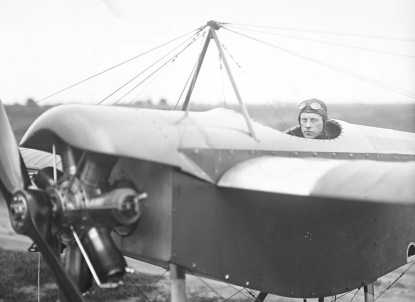
Dyott in the cockpit of his monoplane. Apart from the use of only two struts to support the wires above the wings and an extra pylon under the fuselage, the aircraft was very similar to the Hanriot D.I monoplane.
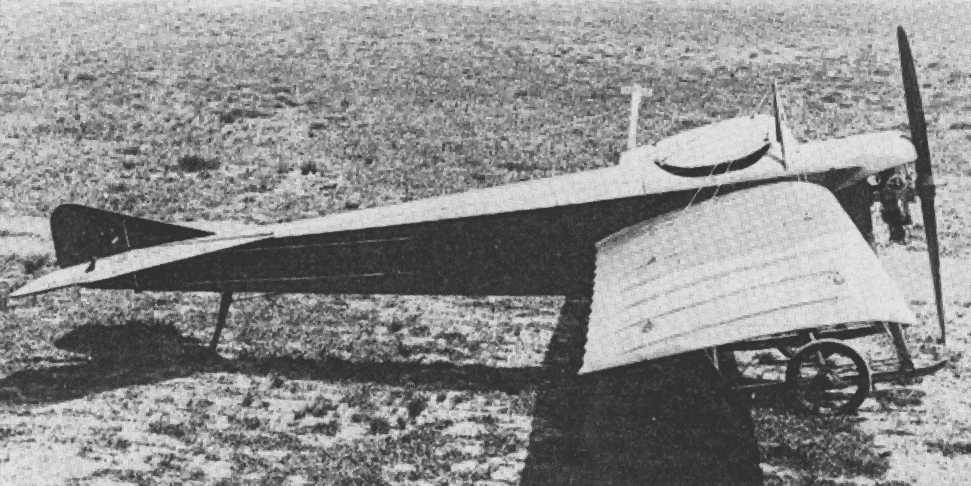
The Dyott monoplane, pictured from the side, showing the small area of rudder.
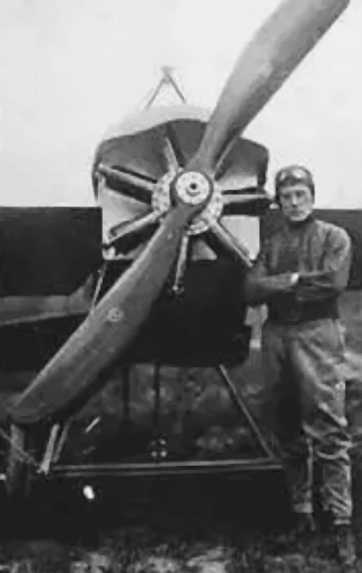
George Dyott, pictured besides his Monoplane, showing the 50 hp Gnome rotary engine. The cowling lip around the top of the engine was there to stop castor oil being thrown back into the cockpit.
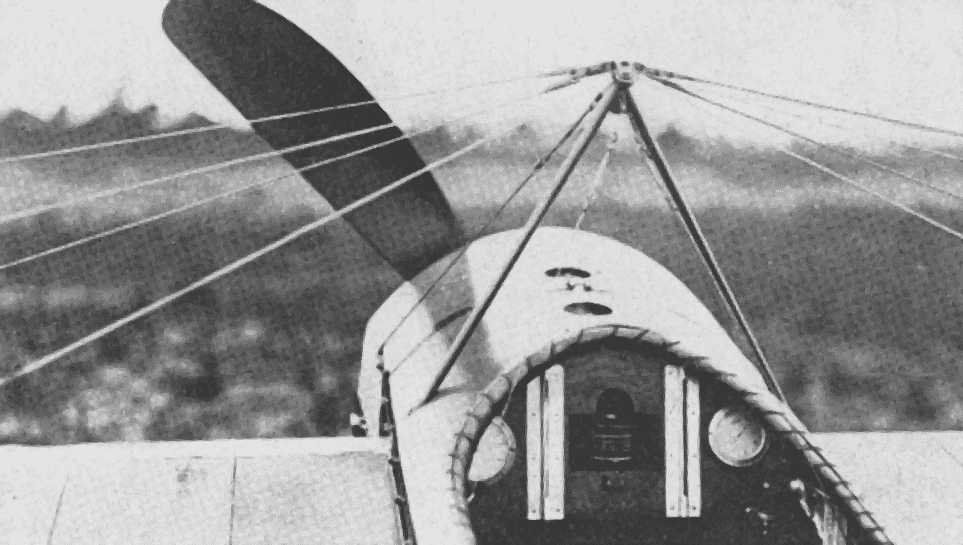
The cockpit of the Dyott Monoplane. The filler caps for the oil and petrol tanks are on top of the fuselage. The aircraft had another reserve fuel tank behind the pilot. The round instrument on the left showed the engine revs, that on the right was an altimeter. A compass was mounted centrally while the two vertical tubes showed the level of the oil and petrol. Rotary engines used a prodigious amount of castor oil.
Dyott seems to have built his new monoplane in the hope that it would be adopted by the British military as a "courier" aircraft. It featured a "despatch box" behind the pilot for holding important military papers. In correspondence with "The Sphere" weekly magazine in April 1913, he said the machine was designed for... "communication from end to end of a battle front which may well extend to over twenty miles in length". He added that he hoped to set up a factory in Leicestershire to build the design in quantity. These plans must have been frustrated by the ban on flying monoplanes by the RFC following the death of his friend, Captain Hamilton. Undaunted, Dyott had his new monoplane shipped off to the USA, where he used it for a prolonged tour, flying over 2,000 miles.⁴ The easily removed wings must have helped with its transport by ship over the Atlantic. In August 1913 the monoplane was damaged in an electrical storm at Asbury Park in New Jersey. It was reported that lightning hit the tent hangar in which the aircraft was stored and that the hangar was then blown out to sea by the strong winds. The monoplane was saved, although it had to be shipped to New York for repairs.
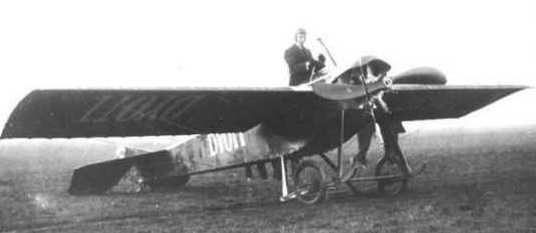
The Dyott Monoplane.
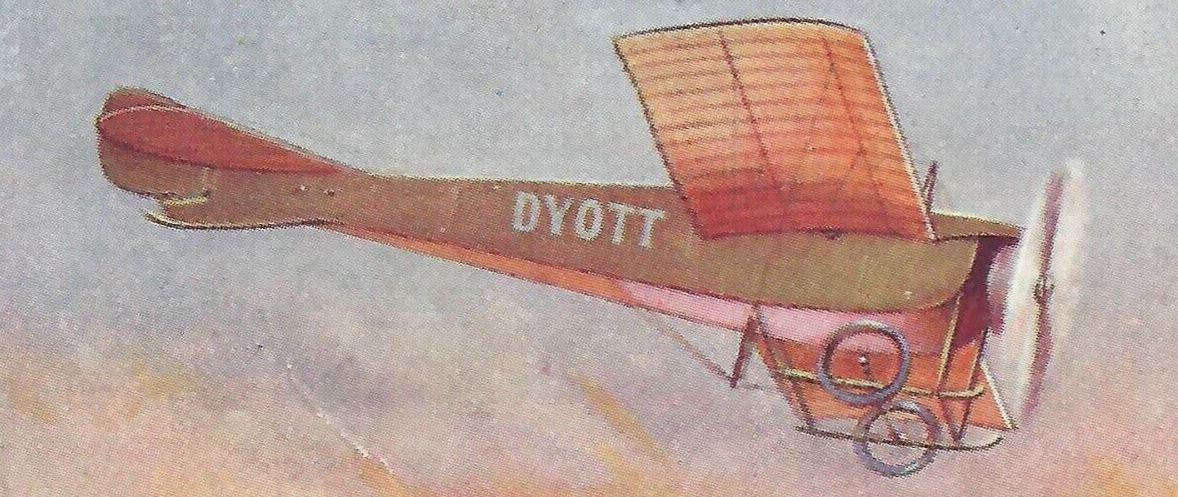
Contemporary collectors card illustration.
By November of 1913, Dyott and his Monoplane were back in Britain, competing in the annual London to Brighton and back air race. He made an excellent start. Unfortunately, he misjudged his position and when he reached the coast he turned east, away from Brighton and then found himself being blown out to sea by strong winds. He managed to bring the Monoplane in for a forced landing on Beachy Head, but at the last moment it was caught by a gust of wind and the aircraft tipped forward, damaging the propeller and nose.
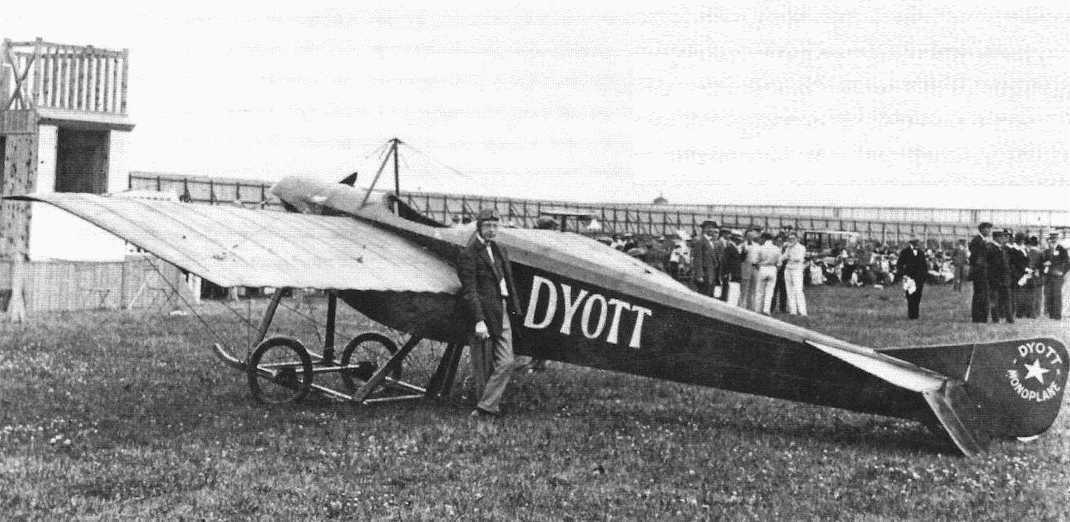
George Dyott, pictured next to his monoplane, perhaps at the start of the London to Brighton Race.
After this, Dyott had the aircraft repaired and was preparing it for a long-distance flight to India. Dyott's flying in the USA and Mexico seems to have awakened him to the possibilities of aviation to help in the exploration, mapping and photographic recording of the lesser-known corners of the world. It was probably in the early part of 1914 that his thoughts turned to the best type of aircraft to undertake such tasks, but without the means of financing its building, he had to stick to the monoplane he already had.
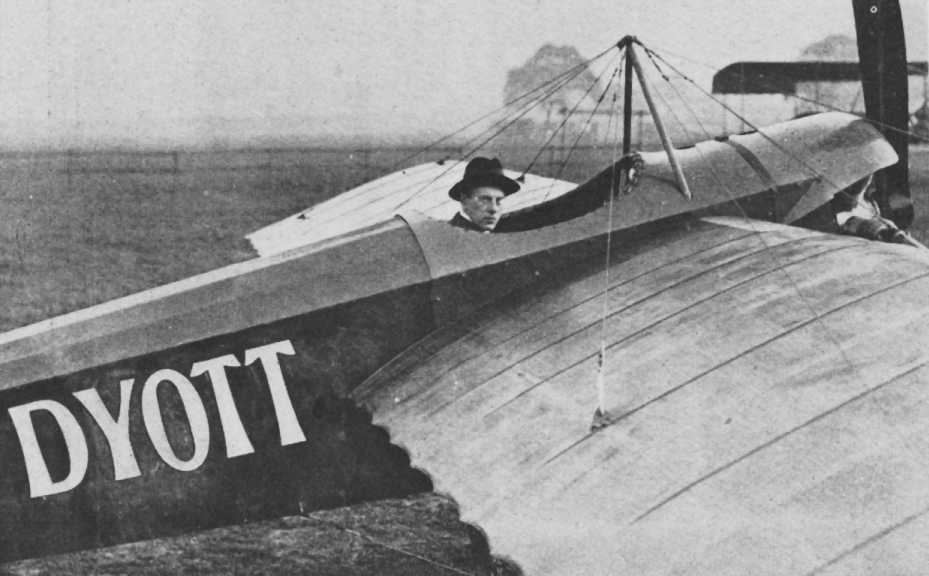
Dyott in his monoplane, showing the top pylon and the scalloped rear edge of the wing.
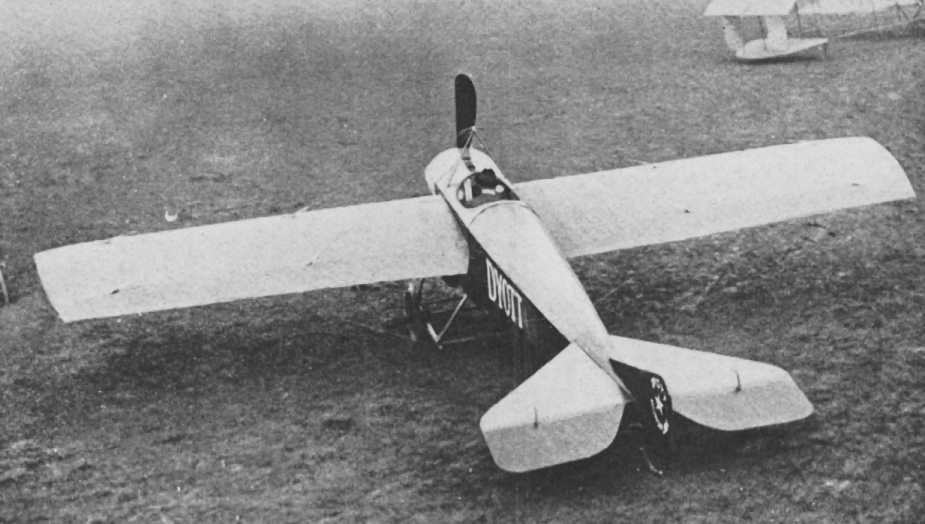
Another view of the Dyott Monoplane.
The declaration of War with Germany, in August 1914, put a stop to Dyott's plans for a flight to India. Instead, he volunteered for service in the Royal Naval Air Service (RNAS). As an experienced aviator, Dyott was snapped up and put through a brief period of training. The London Gazette lists him as being appointed as a Flight Sub-Lieutenant on the 12th of September 1914. He is named as having been the pilot of a Bristol TB8 biplane that crashed on takeoff at Gosport on the 14th of December 1914. He was promoted to be a Flight Commander, operating out of the RNAS base at Dover. It is possible that he used his own monoplane but without it being on the official strength of the RNAS, its longer-than-normal endurance would have been ideal for patrols along the Channel Coast. In 1915 the Monoplane was refurbished by Hewlett & Blondeau and was then properly impressed into service (allocated serial number 1599), being delivered to Dover in September 1915. However, it did not last long, being scrapped through "fair wear-and-tear" at the end of January 1916.
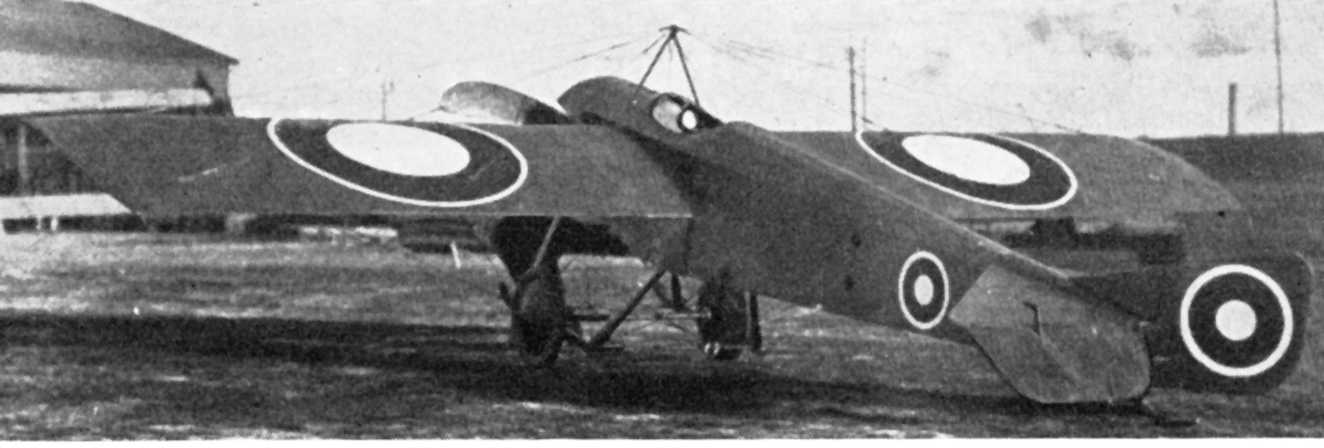
The Dyott monoplane in RNAS service. Seen here with the early red and white identification markings used by the RNAS before the adoption of the red-white-blue roundel.
The Dyott AT Biplane "Battleplane".

An innovative twin-engined patrol and reconnaissance aircraft, the Dyott Type AT biplane has been largely misrepresented as a bomber.

The first Dyott AT prototype on its tricycle undercarriage with cowlings removed from its 120 hp Beardmore engines.
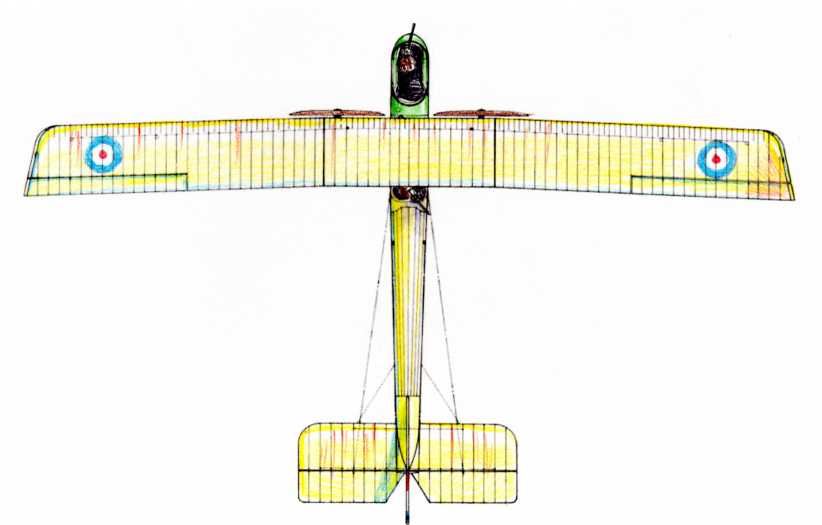
Top view of the Dyott AT, showing the high-aspect-ratio wings with slight sweepback.
It is often forgotten that the main preoccupation of the Royal Naval Air Service during WW1 was keeping the English Channel open for Allied shipping. The constant stream of ships carrying troops and munitions to France from the UK needed protection from German surface raiders, torpedo boats and submarines. To detect such threats the RNAS needed aircraft with long endurance to mount patrols over convoys and keep watch on the Belgian coast occupied by the Germans. Dyott must have thought back to his formative design for a twin-engined exploration and survey aircraft and thought it ideal to undertake such patrols. Sometime in the first half of 1915, he asked the Admiralty for financial support to build his project. The Royal Navy had a policy of financing and ordering aircraft proposed by British Industry and then ordering increased quantities of those designs that did best, "survival of the fittest" if you like. So it is perhaps no surprise that Dyott's design was picked up to be bankrolled for the production of two prototypes, to be built by Dyott's old friends Hewlett & Blondeau. Called the "Type AT" the meaning of "AT" is not recorded. Dyott was released from his flying duties and seconded to Hewlett & Blondeau to complete his design and oversee the building of the AT.
Even before the start of the war, increased orders for aircraft forced Hewlett & Blondeau to acquire much larger factory space at Leagrave on the outskirts of Luton, north of London. It was here that Dyott's twin-engined patrol aircraft would be built. The factory did not have its own airfield, so its products had to be shipped out by train to be erected elsewhere before flight. It seems that before WW1, probably because of Gustave Blondeau's connections with France, they concentrated on licence production of French Hanriot aircraft that were exported to Russia and France. In the 1913 and 1914 editions of "Jane's All the Worlds Aircraft" the company was listed as "British Hanriots". When war was declared they received large orders for aircraft. The main types built by the company were the Avro 504 and the 90-horsepower RAF1 engined version of the Armstrong Whitworth FK3. The company was also contracted to build two of the prototypes of the strange-looking AD Scout fighter, designed by the Admiralty Air Department.
Even before the start of the war, increased orders for aircraft forced Hewlett & Blondeau to acquire much larger factory space at Leagrave on the outskirts of Luton, north of London. It was here that Dyott's twin-engined patrol aircraft would be built. The factory did not have its own airfield, so its products had to be shipped out by train to be erected elsewhere before flight. It seems that before WW1, probably because of Gustave Blondeau's connections with France, they concentrated on licence production of French Hanriot aircraft that were exported to Russia and France. In the 1913 and 1914 editions of "Jane's All the Worlds Aircraft" the company was listed as "British Hanriots". When war was declared they received large orders for aircraft. The main types built by the company were the Avro 504 and the 90-horsepower RAF1 engined version of the Armstrong Whitworth FK3. The company was also contracted to build two of the prototypes of the strange-looking AD Scout fighter, designed by the Admiralty Air Department.
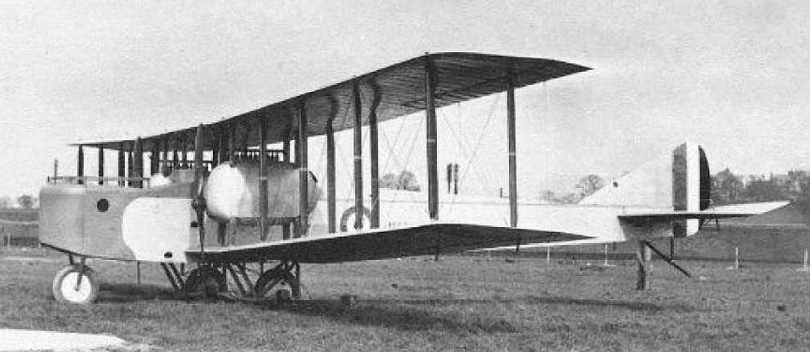
The Dyott AT, as it was originally assembled, with cowlings around its Beardmore engines. Just where are the radiators for the liquid-cooled engines?
At the time it was first designed, the AT biplane was a remarkably large aircraft. It had no less than 5 bays to the nearly equal-span, high-aspect biplane wings (6 bays if you count the engine mountings). The pilot's cockpit was located on the port side of the fuselage to get a good view of the ground to better judge landings. This allowed access from a large open position in the nose of the aircraft to another open position under the wings' trailing edge. Very unusual for the time, the aircraft had a nosewheel, which it used for taxiing, although it still had a large tailskid to prevent damage to the tail on takeoff and landings. The two engines were suspended between the wings with fuel provided by pipes to the fuel tank in the fuselage.
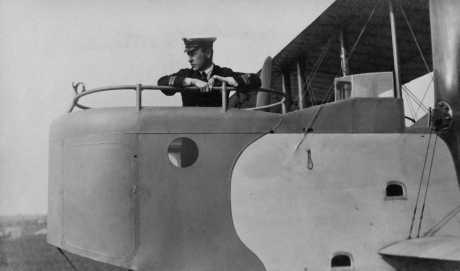
Dyott in the large, open observation/gunner's nose position on the first AT biplane. It has a prominent guard rail which doubled as a support for weapons.
The engines used on the Dyott AT biplane were two Beardmore 120-horsepower units. These were license-built versions of the Austrian Austro-Daimler power unit (the license was negotiated well before the war began). This was a sturdy, reliable engine that was used on many types of single-engined British aircraft in the early-to-mid years of WW1. However, it was quite heavy, which detracted from its performance. Its use on the Dyott AT may have been prompted by its availability to Hewlett & Blondeau; they were fitting it into the Armstrong and Whitworth FK3s they were building because of a shortage of 90 horsepower RAF1 engines (interestingly the weight of the Beardmore engines meant that performance of the FK3s built with them was largely the same as those with the lower-powered RAF1 engine). With hindsight, the Beardmore was not powerful enough to give the Dyott AT a decent performance; more powerful engines that were shortly to be put into production would have been a better choice. The Airco DH3 bomber prototype that was also powered by two of the Beardmore 120 hp engines had a very disappointing performance and was cancelled, although a later development with more powerful Liberty engines was just entering service at the end of the war as the DH10 "Amiens".
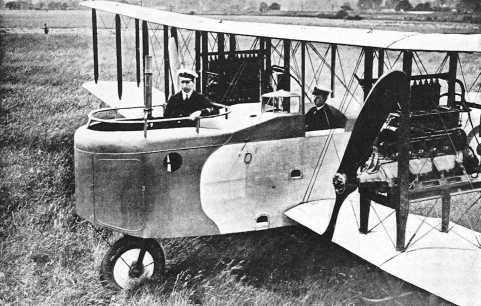
Another view of the first AT biplane. A single Lewis gun is mounted on the guard rail. The front observer/gunner gained entry via a door in the nose, while the pilot had hand and foot holds in the side of the fuselage to climb up into the cockpit, which was offset to one side for a better view of the ground. The Bearmore engines are uncowled, looking like giant steampunk exhibits suspended between the wings. There are no frontal radiators to be seen. Could the radiators be part the "bed" that the engines seem to be sitting on?
Dyott seems to have had a fractious relationship with the authorities about the building of the AT. Letters to his superiors complain about late payment for materials and work, poor cooperation from some departments of the Navy and interference with his design from government inspectors. He bridled at suggestions that his design did not have a sufficient load-bearing safety factor. The timing of the project probably has a bearing on these issues. If Dyott had had his design ready and accepted for building in the heady first months of the war it would have probably been pushed through into quick production like many of the other aircraft ordered by the Admiralty in 1914. However, by early 1916, many of those aircraft ordered in haste in 1914 or early 1915 had proved to be "duds". For every successful aircraft like the Sopwith Baby, there was a failure like the Pemberton-Billing PB25. Many of the failures were due to structural weakness, so it was no surprise that the Admiralty were having their inspectors look at all aspects of the designs under order. Hewlett & Blondeau had issues of their own. Although the company had expanded rapidly to cope with the increase in orders and the quality of the airframes they produced was high, the company was on the verge of financial collapse. Both Hewlett and Blondeau were hard-working, Hilda Hewlett particularly so (she reportedly worked 17-hour days). However, neither was particularly financially minded and the way the factory had expanded so quickly meant it was working very inefficiently. A Mr Ashley Pope was called in by the authorities to inspect the factory. The report he gave in was fairly damning of the work practices there (although he acknowledged that everyone worked hard). One of the major issues he picked up on was that the whole factory was at risk of burning down because people were allowed to smoke, even though surrounded by the combustible wood, linen and dope used in aircraft construction. After submitting his report, Mr Pope was appointed manager of the factory, after which it was reorganised for more efficient and profitable production.
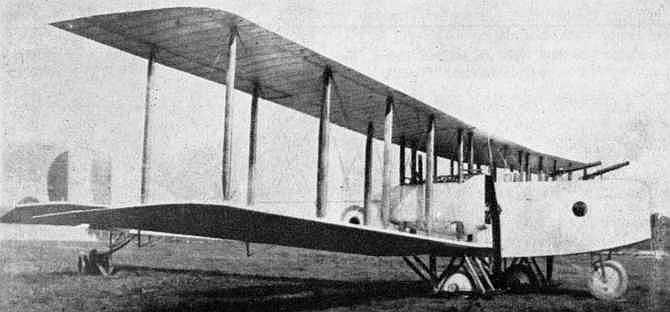
The second AT biplane, 3688, with guns mounted in the nose. The rear tail skid has been propped up so that the nosewheel touches the ground.
The major parts of the AT biplane were too big to be shipped by rail, so a place close to Luton had to be found for its assembly and flight testing was needed. In a letter to his superior, Dyott suggested the RNAS airfield at Chingford (this seems to be where the AD Scout prototypes built by Hewlett & Blondeau were assembled and flown). However, this was rejected and the first AT biplane prototype (serial number 3687) was taken in pieces by road to the aerodrome at Hendon for assembly, starting on 12th April 1916. The engines were tested on the 15th of April before its first flight on the 28th of April 1916 (one source says the 25th April⁵). The pilot of the first flight was of course George Dyott himself. During the initial test flights the engines overheated, so the engine cowlings were removed which solved the issue (notably, there is no sign of traditional frontal radiators on this first prototype). Further tests showed up the need for a bigger tailplane, so a new one was built at Leagrave and shipped down to be fitted at the end of May 1916. Testing continued through the summer of 1916, including the fitting of a camera in a hatch in the floor, essential for its reconnaissance and survey role.
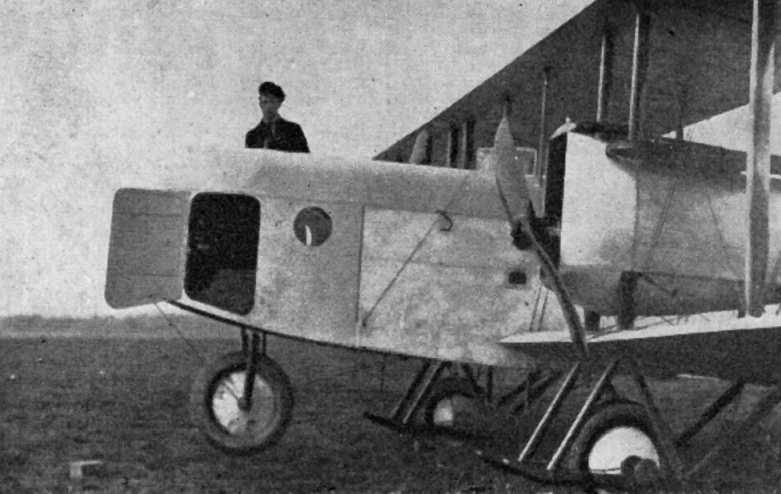
The second prototype (3688) had a revised undercarriage. The main wheels were positioned further forward so that the balance of the aircraft shifted back so that the aircraft sat on its tail skid for taxiing and takeoff. The front nosewheel was retained to stop the aircraft from nosing over if it pulled up too abruptly.
During 1915 and into 1916 the whole nature of aerial warfare had changed from that assumed at the outbreak of war. The advent of dedicated fighter aircraft with forward-firing armament meant that a large slow-flying aircraft would be very vulnerable. The AT had a cruising speed of 71 mph (114 kph), about the same as the contemporary Handley Page O/100 and German Gotha GIII twin-engined bombers. That wasn't too bad compared to a 1915 vintage Fokker Eindekker fighter (top speed 87 mph, 140 kph), but by the summer of 1916, the Germans were introducing fighters like the Albatross DI with top speeds of 110 mph ( 177 kph). To survive any encounter with an enemy aircraft the AT would require defensive armament. Fortunately, the AT's roomy front and rear open positions provided ample scope for mounting machine guns. In fact, the AT biplane seems to have been seized upon for the experimental fitting of armament. In October 1916, after its initial testing at Hendon, the first prototype was sent off to the Experimental Armament Depot at the Isle of Grain for the rest of the war. It would have been the ideal vehicle to research the concept of the heavily-armed, long-endurance anti-Zeppelin patrol fighter that the Pemberton-Billing PB31 Nighthawk was being developed for. Dyott had been invited to attend the first flight of the Pemberton Billing PB29E, predecessor to the Nighthawk, in January 1916. He wrote a critical report on the design for the Admiralty. It was around this time that the Dyott AT began to be referred to as the "Battleplane", an obvious naval nickname for a heavily armed aircraft⁶. Its official records say it was fitted with an experimental Coventry Ordnance Works (COW) gun in November 1916.
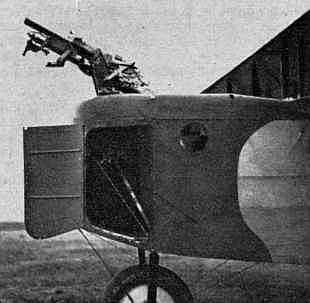
The mystery heavy gun in the nose of the first prototype AT biplane (3687). Is it a 2 pounder "pom-pom"? 1 pounder pom-pom? "COW" gun? Vickers 1.59 QF "Rocket Gun" or French 37 mm TRP gun?
A photo of a large gun in the nose position of the Dyott AT has been variously identified as a "Vickers 2 pounder pom-pom" or the Coventry Ordnance Works (COW) gun. However, it looks just too small to be a pom-pom gun, even the smaller 1 pound and 1½ pound versions and these weapons would probably have been too heavy to be mounted in an aircraft like the AT. The COW gun was certainly recorded as being fitted to the AT, but the weapon in the photo does not look like a COW gun. One possibility is the Vickers 1.59 QF gun (sometimes mistakenly called the "Vickers-Crayford Rocket Gun"). The mounting looks somewhat similar to the Vickers 1.59 QF gun fitted on the Vickers FB25 night-fighter prototype (the same type of gun was used operationally by FE2b aircraft in early 1917). Perhaps the strongest contender is the French "Canon d'Infanterie" model 1916 "TRP" gun, that was trialed in numerous French aircraft and also the British Beardmore W.B.V. fighter.
Another weapon said to have been trialled on the aircraft was the American Davis recoilless gun. This weapon was produced in various calibres, firing either a 2, 6 or 12-pound shell, and operated on the principle of shooting a weight out of the rear of the weapon to counteract the recoil of the shell. Thus it could only be operated in such a position that the rearward firing weight did not strike the aircraft carrying it. It was normally carried in the nose of an aircraft, angled to fire downwards so that the weight was flung high above the aircraft. It seems the "medium" 6-pound version of the Davis gun was experimentally mounted in the nose of the AT, ideal for attacking ships or submarines. More intriguingly, the largest "heavy" 12-pound version was found to fit in the nose of the AT, with one end through the one porthole and the other end through the porthole on the opposite side of the nose. It was hoped that the weapon could be fired to the side, while the AT circled its target in the fashion of a modern AC-130 gunship. Because the Davis gun was reloaded in the middle it was thought that a gunner could have fed shells into the gun while sitting in the nose of the aircraft, while hopefully, the counteracting weights shot out of the opposite side of the gun would not impact the AT biplane.
Just what experiments were carried out with any of the weapons mentioned is unknown. It might be that they were only fitted for trial use on the ground and that the AT biplane never flew with them. The Experimental Armament Depot on the Isle of Grain, where the Dyott AT was based, had an area where aircraft could be parked up and their weapons fired on a gunnery range over the Thames Estuary. The armament specialist H.F. King. writing in his book "Armament of British Aircraft 1909-1939" remarked on the "...astonishing array of small arms undoubtedly fitted, but possibly never lifted".
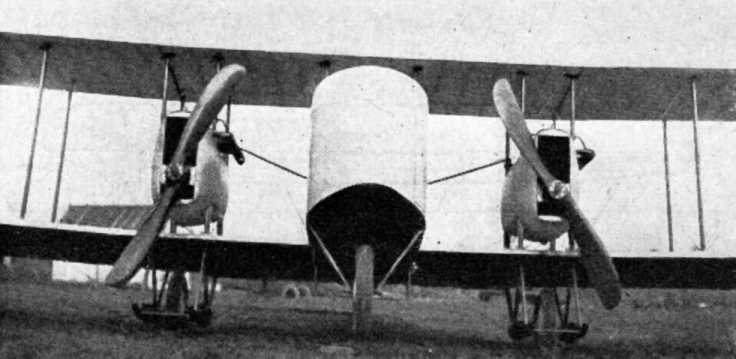
The second prototype, showing the cowled engines with large radiators together with the pipes that took fuel from the fuselage tanks. Note that the aircraft is resting on its tailskid with the nosewheel in the air.
The second prototype (3688) was delivered to Hendon for assembly at the end of August 1916. It first flew on the 5th of October 1916. It had a few differences from the first aircraft. Its Beardmore 120 hp engines now had very large radiators to stop them from overheating, so the engines had neat streamlined cowlings with large exhaust pipes on their port sides. The fuselage was a few inches longer than the first prototype and had a slightly redesigned nose with heightened decking to the front observer position that did away with the guard rail. The aircraft was equipped with a radio. The main undercarriage wheels were moved forward so that the aircraft sat on its tailskid for taxiing and takeoff, but the nosewheel was retained to stop the aircraft from nosing over if it pulled up too abruptly. The reason for the change was probably because early nosewheel aircraft were notoriously difficult to taxi unless the nosewheel could be made steerable, something that added complexity and weight to the aircraft. Even then, early aircraft with steerable nosewheels often developed a violent "shimmy" on takeoff. So it's no wonder that designers stuck to tailskids and tailwheels for so long.
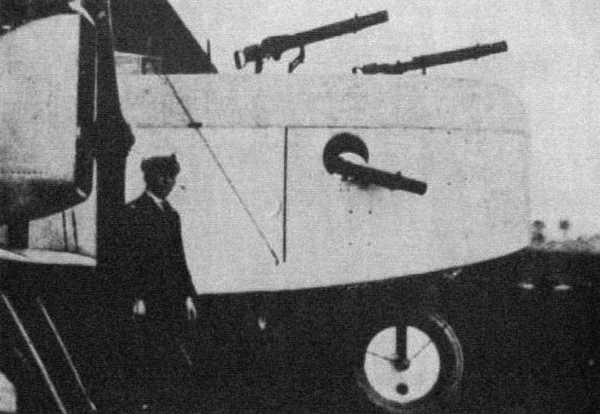
The second prototype, showing the revised nose without the "guard rail" around the front open position. Two Lewis guns are mounted in the front position with another poking out of the porthole.
After its initial trials at Hendon, the second AT (3688) was quickly sent to the RNAS airfield at Eastchurch on the Isle of Sheppey, where it arrived on the 18th of October 1916. It may have been used for patrols over the Thames Estuary. Late in 1916, it was sent to the RNAS base at Dunkirk in France for further service trials but seems to have been returned soon after. It was then allocated to the Eastchurch "Design Flight" but was then returned to Dunkirk in January 1917. It was retired from service and ordered broken up for parts at the end of March 1917 with the ominous note on its records "This machine is devoid of the necessary flying qualities of this station."

The second Dyott AT, clearly showing the 5-bay biplane wings (one bay inboard of the engines the other four outboard of the engines).
There seems to be no evaluation report on the AT biplane, so it is impossible to know what the RNAS officially made of the type or why it was not picked up for production. Although the note on the record for 3688 indicates it may have had some serious shortcomings. However, by mid-1916, the long-endurance patrol mission it had been designed for was being taken care of by blimp airships and Curtiss flying boats, with the much-improved "Felixstowe" flying boat on the verge of being introduced. The twin-engined Handley Page O/100 bomber was also being introduced into service with the RNAS, which would also go on to be used for patrols over the English Channel and North Sea in 1917, sometimes armed with the 6-pounder version of the Davis recoilless gun.

The second AT built, serial number 3688.
One obvious use for the Dyott AT would have been as a bomber, and a load of either six or nine 65 lb (30 kg) bombs seems to have been proposed (a small bombload compared to the contemporary Handley Page O/100 and O/400 bombers). However, the Dyott AT did not have a dedicated bomb bay, so the bombs would have had to be suspended under the fuselage or wings. The Dyott AT was never actually fitted with bombs so its listing as "The Dyott Bomber" in most publications and websites is open to debate. Its identification as "The Dyott Bomber" seems to have started when it was listed in Peter Lewis' book "The British Bomber since 1914" published in 1967. The official name for the Dyott AT in RNAS records was "Dyott twin-engined tractor fighter biplane" and Hewlett & Blondeau seemed to refer to them as "Dyott Fighters".
The first Dyott AT (3687) survived at the Experimental Armament Depot at Grain until at least the end of May 1918. At some stage, it was upgraded with a larger rudder with a horn balance and more powerful 230 horsepower B.H.P. engines. This may have been in the period April to May 1917 when the aircraft's records show work of an unspecified nature was being carried out on the aircraft. These engines had frontal radiators but their installation in the AT was still uncowled. The BHP engines were built by the Galloway Engineering company in Scotland, an offshoot of the Beardmore organisation, they were also called "The Galloway Adriatic" engine. B.H.P. stood for the principal figures in the design of the engine: Sir William Beardmore, Frank Halford and Thomas Pullinger. These engines might have been expected to give the AT biplane the boost in performance it needed to gain a production contract and George Dyott seemed to have kept up the pressure for a limited production run of 5 aircraft. However, no figures for the performance of the aircraft with the more powerful engines seem to have survived and no further AT biplanes were built.
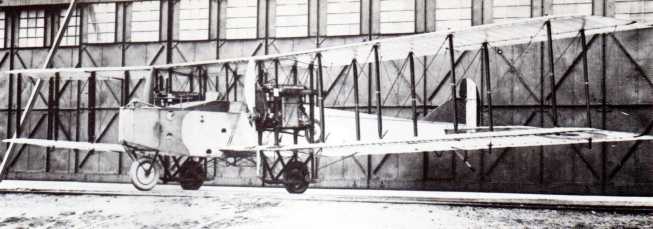
The first Dyott AT biplane, serial number 3687, sitting on its nosewheel. This photo shows it in 1918, in front of a hangar at the Isle of Grain RNAS airbase. It has been fitted with the larger 230 horsepower BHP engine, although they are still uncowled. Notice the larger rudder with horn balance fitted to this aircraft late in its service career.
Dyott AT Specifications
Cruising Speed (Serial 3687 with 120 hp engines): 71 mph (141 kph).
Best Climbing Speed (Serial 3687 with 120 hp engines): 60 mph (96 kph).
Climb to 10,000 feet (3,048 metres): 39 minutes.
Fuel Capacity (Serial 3688): Petrol 115 Imp gallons (523 litres) Oil: 6 Imp gallons (27 litres).
Wingspan upper wings: 70 feet (21.336 metres) Wingspan lower wings: 7 foot 6 inches (21.488 metres).
Length, Serial No 3687: 45 feet 3 inches (13.792 metres) Length, Serial No 3688: 45 ft 9 inches (13.944 metres).
Engines in 3687 and 3688: Two Beardmore 120 hp (Austro-Daimler licence built).
Engines later fitted to 3687: Two Galloway Adriatic 230 hp B.H.P. engines.
Afterwards...
After the War, Dyott became an explorer, travelling in India, Africa and South America. He still advocated survey and mapping by aircraft, writing an article "An Air-Route Reconnaissance from the Pacific to the Amazon" for the London Geographical Journal in 1920. It was in South America that he earned his greatest fame. In the early 1920s he did a series of expeditions in the Andies and Amazon which he documented in his books "Silent Highways of the Jungle" and "On the Trail of the Unknown". In 1927 he led an expedition down the "River of Doubt" to vindicate the claims of Theodore Roosevelt's 1913-14 expedition. After getting married in New York in 1928, Dyott left straight away on another expedition to search for the disappeared explorer Henry Fawcett, writing a book "Man Hunting in the Jungle" about his experiences. He lived for much of his life in South America, at one stage running a company based in Peru that did aerial survey and photographic work (the job the Dyott AT biplane had been designed for). He narrated a series of documentary films about his expeditions in the late 1920s and early 1930s, using film he had taken himself. Some of these were serialised as "Mysteries of the Magic Vault". In these, he displayed a surprisingly modern appreciation for the natives he met. In 1933, he wrote and appeared in the feature film "Savage Gold" based loosely on his expedition to search for Henry Fawcett, notable for actually being filmed in South America with real South American natives, rather than Hollywood extras. His 1935 book "Nip and Tuck" is about an animal collecting expedition in India, where amongst other animals, he obtained two small Himalayan bears that became a star attraction in a New York Zoo. Dyott apparently returned to the UK during the Second World War although the nature of the work he did is not known. In the late 1940s, he is reputed to have mounted expeditions into the Andes in search of the fabled "Treasure of the Llanganatis". His 1928 expedition to find Henry Fawcett was the subject of the 1958 feature film "Manhunt in the Jungle". He only returned to his family in the USA late in his life. He died in New York in 1972.
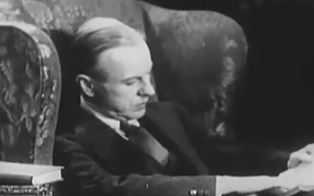
George Dyott in the 1930s, pictured in the introduction to one of the travel documentaries he filmed and narrated.
During WW1, Hewlett & Blondeau had built 24 examples of the BE2c, 400 examples of the Armstrong Whitworth FK3s, and 400 Avro 504s. After the war, the availability of surplus military aircraft meant there was little call for new aircraft construction. Without their own airfield, the company struggled to repair or maintain existing aircraft. So they turned to building agricultural equipment. One of their products was a small paraffin engine for driving sawing and threshing machinery. The company did not prosper and closed in 1920. In 1926 the factory was sold to Electrolux who still own much of the site today. Gustave Blondeau stayed in the Luton area, he died in 1965. The redoubtable Hilda Hewlett travelled the world before settling in New Zealand. She died in 1943. The Royal Air Force's 3D scanning and printing facility, housed at RAF Wittering, is named after her.
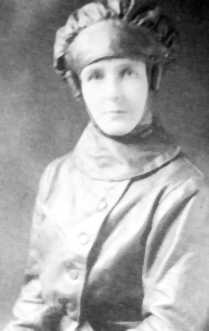
Hilda Hewlett in her flying outfit.
Notes
Notes
¹ It was obligatory to get an Aero Club Certificate to fly solo in the UK. The Aero Club of America began issuing certificates in 1911 but they were not mandatory to be able to fly solo in the USA until after WW1. That is why Captain Patrick Hamilton could fly in America but had to get an Aero Club certificate when he got back to the UK.
² By coincidence, some 60 years later, George Dyott was to be buried only 100 yards from Quimby's grave in Valhalla, New York.
³ Mulliner's Aerocraft Works was a short-lived enterprise (1910-1912), spun off from the Mulliner coach-building firm that also had interests in various armament companies. The factory assembled some Blériot-type monoplanes and did general repairs. The company also promoted the "Knyplane", a monoplane with variable incidence wings designed by E. C. Kny.
⁴ All this to and fro across the Atlantic might seem strange and very expensive, especially as the aircraft had to be shipped over the ocean as freight. However, prior to WW1, exhibition flying in the USA could be very lucrative for European aviators. The early advantage of the Wright brothers was squandered by their secretive methods, only wanting to give demonstrations to investors or governments willing to pay for their expertise. Meanwhile the Europeans had lept ahead, especially the French in engine technology. The free public demonstrations that had accompanied the early flights of pioneers like Henry Farman in France meant the European public expected demonstrations of flying to be free to view or cost very little. Over in the USA, entrepreneurs would organise displays that the public would pay high prices to see. However, this could all backfire if weather conditions prevented or curtailed flying, then the crowds would often riot!
⁵ Michael H Goodall (see sources below) gives the date of the AT's first flight as being on the 25th April 1916. Sturtivant and Page (see sources below), quoting the aircraft's official record card, gives the date as the 28th April.
⁶ Later, in the 1920s and through into the 1930s, the term "battleplane" became associated with the theories of air strategy held by people such as Giulio Douhet, who advocated fleets of self-defending heavy bombers.
Early Aviators Website snippets of information on Dyott, including an informative letter from his son.
"The Lothians" blog article on Captain Patrick Hamilton
Historic Wings Website commentary on Dyott's report on flying in Mexico in a January 1913 edition of "Flight" magazine.
Historic Wings Website commentary on the Dyott monoplane and its "flight recorder".
Historic Wings Website article on Hilda Hewlett.
An article about the Hewlett & Blondeau factory.
An archived article on the "Wayback Machine" about Hewlett & Blondeau and their agricultural "Omnia" engine.
An archived article on the "Wayback Machine" about Matilde Moisant with many references to the Mexico trip.
Archived copy of Flight magazine from 16th December 1911 on the "Wayback Machine" describing Dyott and Hamiltons flight with a searchlight at "Nassau Airfield", Long Island, New York, USA.
Biography of Matilde Moisant, including an account of the Mexico trip.
Some of George Dyott's travel documentaries
You can watch George Dyott in a mute copy of the film "Savage Gold" for free on the British Film Institute website.
Article about Dyott's report on the Supermarine PB29E.
Sources
"The Lothians" blog article on Captain Patrick Hamilton
Historic Wings Website commentary on Dyott's report on flying in Mexico in a January 1913 edition of "Flight" magazine.
Historic Wings Website commentary on the Dyott monoplane and its "flight recorder".
Historic Wings Website article on Hilda Hewlett.
An article about the Hewlett & Blondeau factory.
An archived article on the "Wayback Machine" about Hewlett & Blondeau and their agricultural "Omnia" engine.
An archived article on the "Wayback Machine" about Matilde Moisant with many references to the Mexico trip.
Archived copy of Flight magazine from 16th December 1911 on the "Wayback Machine" describing Dyott and Hamiltons flight with a searchlight at "Nassau Airfield", Long Island, New York, USA.
Biography of Matilde Moisant, including an account of the Mexico trip.
Some of George Dyott's travel documentaries
You can watch George Dyott in a mute copy of the film "Savage Gold" for free on the British Film Institute website.
Article about Dyott's report on the Supermarine PB29E.
Sources
The Dyott Battleplane: An article by Michael H Goodall in the March 1973 edition of Air Pictorial magazine. Some of the dates and timings in this article are at odds with the official records of the two AT aircraft, which are reproduced in Sturivant and Page's book (see source below). I've used the dates in Sturivant and Pages book wherever they clash.
Royal Navy Aircraft Serials and Units 1911-1919: By Ray Sturtivant and Gordon Page, published by Air Britain in 1992. ISBN: 9780851301914
Flights of Fancy - Early Aviation in Battersea and Wandsworth: By Patrick Loobey, published by the Recreation Department of Wandsworth Borough Council. ISBN 0 902837 117. The account of the setting up of the Hewlett and Blondeau works in Vardens Road is backed up by quotes from local newspapers.
Armament of British Aircraft 1909-1939: By H.F. King, published by Putnam in 1971. ISBN: 0 370 00057 9.
A report on the Dyott Monoplane's performance in the London to Brighton race appeared in the 13th of November 1913 edition of The Aeroplane magazine.
Warning - As of January 2025, a lot of the information about both the Dyott "Bomber" and Dyott Monoplane on Wikipedia is wrong or misleading. It has the wrong dates and location for the first flight of the AT biplane, it describes it as being a 4-bay biplane, instead of 5-bay and the picture of the Dyott monoplane is of a completely different aircraft!
Royal Navy Aircraft Serials and Units 1911-1919: By Ray Sturtivant and Gordon Page, published by Air Britain in 1992. ISBN: 9780851301914
Flights of Fancy - Early Aviation in Battersea and Wandsworth: By Patrick Loobey, published by the Recreation Department of Wandsworth Borough Council. ISBN 0 902837 117. The account of the setting up of the Hewlett and Blondeau works in Vardens Road is backed up by quotes from local newspapers.
Armament of British Aircraft 1909-1939: By H.F. King, published by Putnam in 1971. ISBN: 0 370 00057 9.
A report on the Dyott Monoplane's performance in the London to Brighton race appeared in the 13th of November 1913 edition of The Aeroplane magazine.
Warning - As of January 2025, a lot of the information about both the Dyott "Bomber" and Dyott Monoplane on Wikipedia is wrong or misleading. It has the wrong dates and location for the first flight of the AT biplane, it describes it as being a 4-bay biplane, instead of 5-bay and the picture of the Dyott monoplane is of a completely different aircraft!
